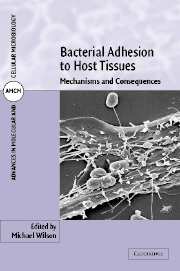Book contents
- Frontmatter
- Contents
- List of contributors
- Preface
- Part I Bacterial adhesins and adhesive structures
- Part II Effect of adhesion on bacterial structure and function
- 7 Transcriptional regulation of meningococcal gene expression upon adhesion to target cells
- 8 Induction of protein secretion by Yersinia enterocolitica through contact with eukaryotic cells
- 9 Functional modulation of pathogenic bacteria upon contact with host target cells
- Part III Consequences of bacterial adhesion for the host
- Index
- Plate section
7 - Transcriptional regulation of meningococcal gene expression upon adhesion to target cells
Published online by Cambridge University Press: 08 October 2009
- Frontmatter
- Contents
- List of contributors
- Preface
- Part I Bacterial adhesins and adhesive structures
- Part II Effect of adhesion on bacterial structure and function
- 7 Transcriptional regulation of meningococcal gene expression upon adhesion to target cells
- 8 Induction of protein secretion by Yersinia enterocolitica through contact with eukaryotic cells
- 9 Functional modulation of pathogenic bacteria upon contact with host target cells
- Part III Consequences of bacterial adhesion for the host
- Index
- Plate section
Summary
INTRODUCTION
Initial interactions between pathogenic bacteria and target cells are crucial events in cell infection. Bacteria have developed various regulatory networks to interact with their hosts. These mechanisms tend to favour bacterial survival and multiplication in infectious sites.
In extracellular bacteria such as Neisseria meningitidis and Neisseria gonorrhoeae, several structures have evolved to permit efficient adhesion to target cells. These two species are exclusive human pathogens. Neisseria meningitidis–host cell interactions alternate between asymptomatic carriage and invasive infections. The organism provokes septicaemia and then may invade the subarachnoidal space and causes meningitis. Other localizations are also observed, such as arthritis. Meningococcal infections occur as sporadic or epidemic cases. Factors that provoke meningococcal epidemics have not been fully elucidated. They are thought to be related to both host and bacteria as well as to the environment. Meningococcal strains involved in epidemics are usually different from those isolated from sporadic cases. Using genetic typing approaches, epidemic clones can be clustered into a few groups (clonal complexes). The percentage of healthy carriers in the general population is about 10%; however, very few individuals develop invasive infections. Moreover, meningococcal strains isolated from carriers are highly heterogeneous and differ genetically from invasive strains.
Bacteria first adhere to the epithelium of the nasopharynx and may then be translocated into the bloodstream. To gain entry into the cerebrospinal fluid (CSF), N. meningitidis has to adhere to endothelial cells and to cross the blood–CSF barrier.
- Type
- Chapter
- Information
- Bacterial Adhesion to Host TissuesMechanisms and Consequences, pp. 165 - 182Publisher: Cambridge University PressPrint publication year: 2002
- 2
- Cited by



